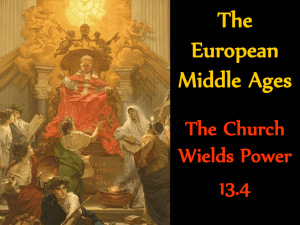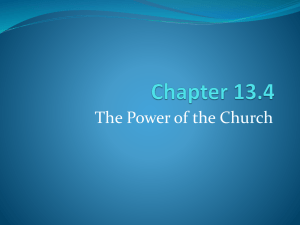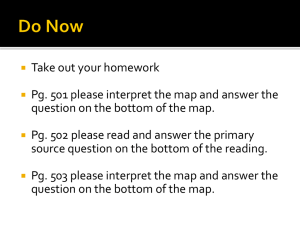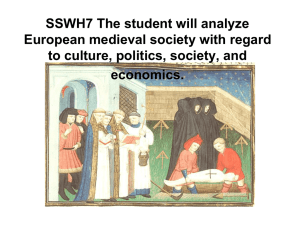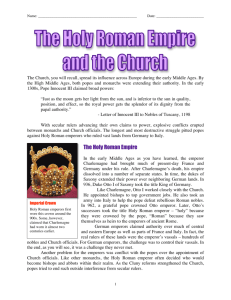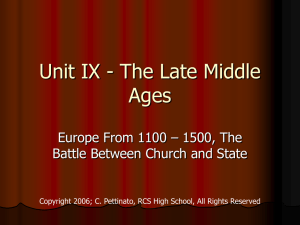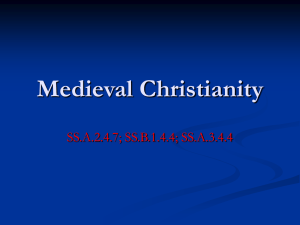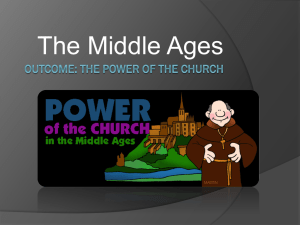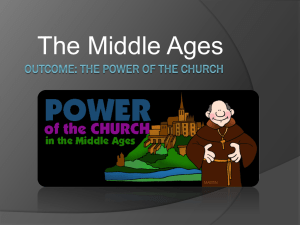The Holy Roman Empire and the Church
advertisement
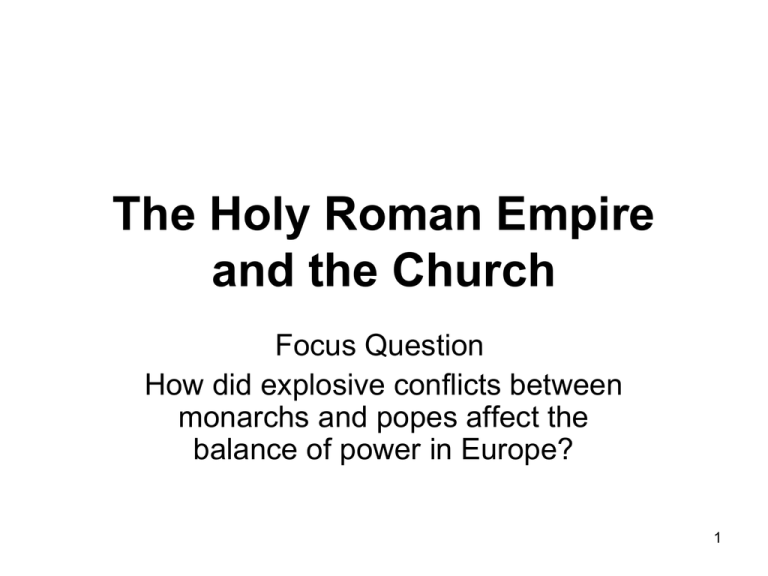
The Holy Roman Empire and the Church Focus Question How did explosive conflicts between monarchs and popes affect the balance of power in Europe? 1 The Holy Roman Empire • In the early Middle Ages, Charlemagne brought much of present-day France and Germany under his rule. After his death, the empire dissolved into a number of separate states. In time, the dukes of Saxony extended their power over neighboring German lands. In 936, Duke Otto I of Saxony took the title King of Germany. 2 Otto I Becomes Emperor • Like Charlemagne, Otto I worked closely with the Church. He appointed bishops to top government jobs. He also took an army into Italy to help the pope defeat rebellious Roman nobles 3 • In 962, a grateful pope crowned Otto emperor. Later, Otto’s successors took the title Holy Roman emperor—“holy” because they were crowned by the pope, and “Roman” because they saw themselves as heirs to the emperors of ancient Rome. 4 Emperors Struggle for Control • German emperors claimed authority over much of central and eastern Europe as well as parts of France and Italy. In fact, the real rulers of these lands were the emperor’s vassals— hundreds of nobles and Church officials. For German emperors, the challenge was to control their vassals. It was a challenge they never met. 5 • Another challenge for the emperors involved the appointment of Church officials. Here, they confronted the power of the popes. Like other monarchs, the Holy Roman emperors often decided who would become bishops and abbots within their realm. At the same time, popes tried to end such interference in the Church from secular rulers. 6 • Describe the Holy Roman Empire. 7 The Feud Between Pope and Emperor • In 1054 Henry IV was crowned king of Germany; later he also became Holy Roman emperor. At that time, Gregory VII was pope. During their reigns, the conflict between monarchs and the Church erupted. 8 Gregory VII Causes Controversy • Many medieval Europeans admired Pope Gregory VII, who instituted many Church reforms. At the same time, his policies aroused hatred and contempt. Gregory wanted to make the Church independent of secular rulers, so he banned the practice of lay investiture. 9 • Under this practice, the emperor or another lay person (a person who is not a member of the clergy) “invested,” or presented, bishops with the ring and staff that symbolized their office. Only the pope, said Gregory, had the right to appoint and install bishops in office. 10 Henry IV Responds • Pope Gregory’s ban brought an angry response from the Holy Roman emperor, Henry IV. He argued that bishops held their lands as royal fiefs. Since he was their overlord, Henry felt entitled to give them the symbols of office. The feud heated up as the two men exchanged insulting letters. Meanwhile, rebellious German princes undermined Henry by supporting the pope. 11 The Struggle Intensifies • In 1076, Gregory excommunicated Henry, freeing his subjects from their allegiance to the emperor. The pope then headed north to crown a new emperor. Faced with revolts, Henry was forced to make peace. In January 1077, he presented himself to the pope as a repentant sinner 12 • Gregory knew that Henry was just trying to save his throne. Still, as a priest, the pope had no choice but to forgive a confessed sinner. He lifted the order of excommunication, and Henry quickly returned to Germany to subdue his rebellious nobles. He also took revenge on Gregory by leading an army to Rome and forcing the pope into exile. 13 A Compromise: The Concordat of Worms • The struggle over investiture dragged on for almost 50 years. Finally, in 1122, both sides accepted a treaty known as the Concordat of Worms (vawrmz). This treaty declared that the Church had the sole power to elect and invest bishops with spiritual authority. The emperor, however, still invested them with fiefs 14 • Describe the feud between the pope and the emperor. 15 The Struggle for Italy • Although the investiture struggle was over, new battles were soon raging between popes and emperors. During the 1100s and 1200s, ambitious German emperors sought to control Italy. As they did so, they came into conflict with popes and with the wealthy cities of northern Italy 16 German Emperors Try to Subdue Italy • The Holy Roman emperor Frederick I, called Frederick Barbarossa, or “Red Beard,” dreamed of building an empire from the Baltic to the Adriatic. For years, he fought to bring the wealthy cities of northern Italy under his control. With equal energy, they resisted. By joining forces with the pope in the Lombard League, they finally managed to defeat Barbarossa’s armies 17 • Barbarossa did succeed, however, in arranging a marriage between his son Henry and Constance, heiress to Sicily and southern Italy. That move entangled German emperors even more deeply in Italian affairs 18 • Barbarossa’s grandson, Frederick II, was raised in southern Italy. An able and arrogant leader, he pursued his ambitions in Italy, clashing repeatedly and unsuccessfully with several popes. Like his grandfather, Frederick also tried but failed to subdue the cities of northern Italy. 19 Effects on Germany and Italy • While Frederick II was involved in Italy, German nobles grew more independent. The Holy Roman Empire survived, but remained a patchwork of feudal states. Unlike France and England, Germany would not become a nation-state for another 600 years 20 • Southern Italy and Sicily also faced centuries of upheaval. There, popes turned to the French to overthrow Frederick’s heirs. A local uprising against French rule in Sicily led to 200 years of chaos as French and Spanish rivals battled for power. The region that had once been a thriving center of culture was left 21 in ruins Church Power Reaches Its Height • In the 1200s, the Church reached the peak of its political power. Reforming popes like Gregory VII claimed the right to depose kings and emperors. Gregory’s successors greatly expanded papal power. 22 Papal Supremacy • In 1198, the powerful Pope Innocent III took office. As head of the Church, Innocent III claimed supremacy over all other rulers. The pope, he said, stands “between God and man, lower than God but higher than men, who judges all and is judged by no one.” Innocent III clashed with all the powerful rulers of his day, and usually won23. • when King John of England dared to appoint an archbishop of Canterbury without the pope’s approval, Innocent excommunicated the king and placed his kingdom under interdict. Innocent ordered the same punishment for France when Philip II tried unlawfully to annul, or invalidate, his marriage. 24 • In 1209, Innocent, aided by Philip II, launched a brutal crusade, or holy war, against the Albigensians in southern France. The Albigensians were a religious group regarded as heretics by the Church because they rejected central Catholic beliefs and rituals. Knights from all over western Europe took part. Tens of thousands of people were slaughtered in the Albigensian 25 Crusade • Innocent strengthened papal power within the Church as well. He extended the Papal States, reformed the Church courts, and changed the way that Church officials were chosen. Finally, he called a council that issued decrees that justified the pope’s new powers. 26 Looking Ahead • After Innocent’s death, popes continued to claim supremacy. During this period, though, the French and English monarchies grew stronger. In 1296, Philip IV of France successfully challenged Pope Boniface VIII on the issue of taxing the clergy. After Philip engineered the election of a French pope, the papacy entered a period of decline 27
